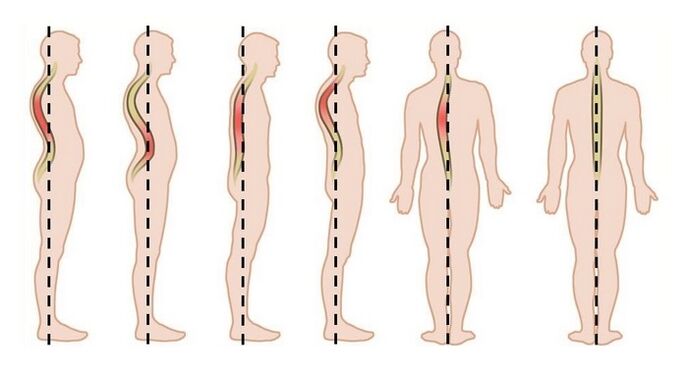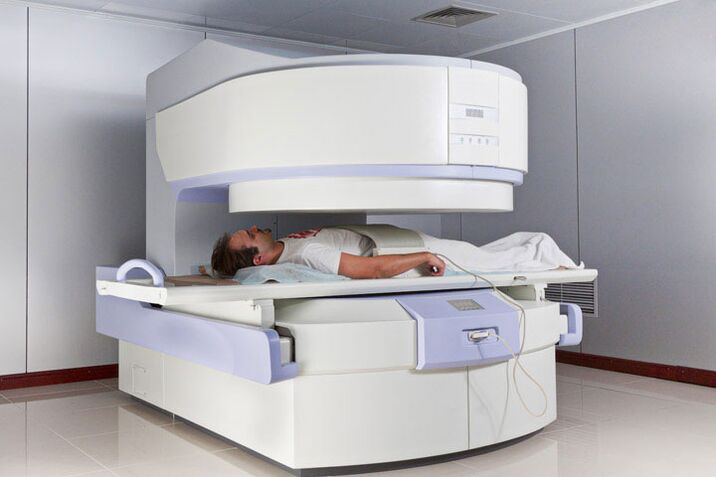
Osteochondrosis is one of the most commonly diagnosed pathologies of the spine. This pathology has a degenerative-dystrophic nature of origin, affects the intervertebral discs, leading to their structural and external modifications. Doctors define three types of diseases: cervical, thoracic and lumbar osteochondrosis, depending on the location of the disorder in the spinal column. If we talk about the statistics of identified pathologies, it is believed that thoracic osteochondrosis is less common than other types. This is due to the peculiarities of the structure of the human spine in the thoracic region: the intervertebral discs of this part of the back have limited mobility, which significantly reduces the likelihood of their traumatic injury.
What is thoracic osteochondrosis
Recognizing the disease is difficult, because its symptoms are often similar to pathological changes in other organs: heart, stomach and so on. Thoracic osteochondrosis is dangerous in its consequences, so its early detection gives more chances for timely correction and prevention of unwanted consequences. The disease is equally often diagnosed in patients of both sexes of different ages, including children. Let's stop in more detail about the causes of osteochondrosis of the chest, its symptoms, methods of treatment with drugs and at home.
Osteochondrosis of the thoracic spine manifests itself as degenerative-dystrophic disorders in the structure of bones, cartilaginous tissue of the vertebrae, which causes the development of destructive processes in them. In addition to the vertebrae themselves, the intervertebral discs suffer: they stratify, shrink in size, causing the nerve endings in the intercostal space to tighten. All this together affects the normal functioning of the spine. The treatment started at the wrong time worsens the situation, which is subsequently resolved exclusively by surgery, which the patient cannot always resolve for various reasons.
Chest osteochondrosis can cause the development of quite serious and dangerous diseases and conditions. It often becomes the cause of pneumosclerosis, narrowed blood vessels, dysfunction of the genitourinary system, carcinogenic pathologies, etc. If osteochondrosis progresses rapidly, it usually limits a person's physical capabilities: it is difficult for him to walk, work and do his usual activities freely.
With the development of osteochondrosis in patients, initially the bony component of the vertebrae is affected, then the cartilage and, finally, the connective tissue and adjacent muscles.
If the signs of osteochondrosis appear in childhood or adolescence, then this is a dangerous situation, because it indicates that a person's musculoskeletal system has begun to age without complete formation and development. Osteochondrosis of the thoracic spine in a child is rarely diagnosed. But a detected disease often indicates that there is another dangerous disease.
Pathology is approximately equally common in both men and women. There are no age-specific priorities either. But it is worth noting that women are more prone to disease during the period of hormonal changes in the body - menopause.
If you start treatment for thoracic spine osteochondrosis in the early stages, then the chances are much higher that the therapy will give a positive result.
Degree of disease and characteristic symptoms
The development of osteochondrosis of the thoracic spine is gradual, several stages differ. For proper organization of the healing process it is necessary to understand the mechanisms of its development and progression.
- The initial stage of degenerative-dystrophic processes occurring in the spine is characterized by a slight decrease in the size of the intervertebral discs. Minor cracks begin to appear on the surfaces of the annulus of the fibrosus of the intervertebral discs. The disc may be slightly outside the spine. At the same time, thoracic osteochondrosis of the first degree is not detected as a painful sensation, often the person is not aware of the initial dangerous disease. With the help of computed tomography, the protrusion of the discs (their slight loss) is detected.
- If a person has grade 2 thoracic osteochondrosis, then painful manifestations in the back in the thoracic region begin to appear. This is explained by the fact that the nerve fibers are tightened. Musculo-ligament apparatus of the back, ie. muscular corset, provides optimal support to the spine in proper anatomical shape. In order to prevent spinal instability, it is extremely important to form the muscular structures of the back symmetrically. Otherwise, there is not only a violation of posture, curvature of the spine, but also excessive mobility of its individual elements. Due to the increased mobility of the vertebrae, there is a contraction of the nerve fibers that leave the spine through the intervertebral space. How does osteochondrosis manifest in the second stage? Back pain in the second phase of thoracic osteochondrosis necessarily occurs. It has different characteristics: it can be long-term or short-term, in the form of seizures. The situation is aggravated by the fact that the nerve endings are compressed directly in the muscles, which are regularly in increased tone.
- Morphological signs of thoracic osteochondrosis of the third degree are very pronounced, affecting all structural anatomical components of the spine. The patient has the following pathological picture: hernias and protrusions of intervertebral discs appear, muscles and ligaments become inflamed, tears appear on them, vertebrae are displaced, signs of arthrosis of the spinal joints develop. The clinical picture of the disease of the spine in the third stage is very diverse. In addition to the person actually having pain from osteochondrosis of the chest, the patient loses the tactile reaction of the part of the body where the damaged nerve passes; has disorders of the autonomic nervous system, which are accompanied by disturbances in the work of the respiratory and circulatory systems. It becomes difficult for him to breathe, there is pain in the heart, arrhythmia, difficulty breathing. In addition, the patient develops arthrosis of several joints at once, and pathological disorders begin in the work of organs located in the chest area. Similar symptoms occur when the intervertebral fissure shrinks by two-thirds of its height. Its size is estimated by an X-ray of the chest, which is performed in two projections: flat and lateral.
- With the development of degenerative processes in the spine to fourth-degree osteochondrosis, the intervertebral cleft narrows to a minimum distance, dangerous conditions such as spondylosis, spondyloarthritis (characterized by pathological changes in the intervertebral joints), spondylolisthesis (vertebrae develop in the vertebrae). The body mobilizes its compensatory abilities to reduce the static and dynamic load of the spinal column, to prevent injuries to the anatomical elements, due to which the vertebrae grow, flatten and grow with each other. The damaged area of the annulus fibrosus is replaced by a bone structure, osteophytes (bone growths) are formed due to spinal disc prolapse, the spinal cord narrows, the nerve endings are strongly compressed, the motor activity of the thoracic spine is significantly limited, the person has constant chest pain. back.
- As a result of the progression of the disease, the patient has lumbago pain in the lower part of the back (lumbago), the legs are completely or partially paralyzed, the person loses the ability to work, and becomes disabled.
Different symptomatic manifestations of the disease depend on different reasons, including a person’s genetic predisposition. The same symptoms of thoracic spine osteochondrosis fail in different patients in different ways. There is an objective explanation for this: various causes, conditions of occurrence and the general state of human health lead to osteochondrosis. Symptoms of thoracic osteochondrosis in men appear somewhat earlier than in women. The main reason for this phenomenon lies in the physiological structure of the female body: the hormone estrogen protects the intervertebral discs, so particularly favorable conditions for the disease occur during changes in the hormonal background (during pregnancy, menopause).
Many are interested in taking them with osteochondrosis to the military. If a conscript has first-degree osteochondrosis, he will be drafted into the army. In the case when the young man has a pronounced symptomatology of the disease, is observed by a neuropathologist, then the delay is likely, in a neglected state (if there is polysegmental osteochondrosis of the thoracic spine), it may not occur at all.
Reasons for occurrence
Thoracic osteochondrosis at the beginning of its appearance is practically not manifested in anything. However, you need to know why this may occur. The following reasons cause pathology:
- Regular static or dynamic overload of the spine due to active strength training in professional athletes or people who do sports without the necessary load control.
- Traumatic damage to the bones, the articular elements of the spine often lead to them not joining properly, collapsing quickly. Any injury to the spinal column is exacerbated by pathological changes in the functioning of the structures of the nervous and vascular system. The necessary supply of bone nutrients is often restored over a very long period of time.
- Poor posture, congenital or acquired curvature of the spine, which leads to an unbalanced effect on the intervertebral discs.
- Sharp lifting of weights, when most of the load falls on the chest back. If a person constantly performs such movements, then there is a high probability of developing osteochondrosis of the chest.
- Endocrine disorders. In case the metabolic processes are disturbed in the organism, all other organs and tissues do not receive the necessary nutrients, and their regeneration is also incorrect.
- Genetic preconditions for possible pathological processes in vertebrae, intervertebral discs. In this case, thoracic osteochondrosis manifests itself in absolutely any age category.
- Insufficient physical and physical activity of a person, sedentary work. The muscular framework of the back in this situation weakens, tissue nutrition deteriorates, the flexibility of the spine decreases, and the risk of developing thoracic osteochondrosis increases significantly.
- Underdevelopment of all tissues of the musculoskeletal system, which causes degenerative disorders in the spine. The cause is an unbalanced, excessive load on the spine.
- Various pathological changes on intervertebral discs. They can become thinner or, conversely, grow, osteophytes can appear on them, which interfere with the work of the joints, as well as damage the blood vessels and compress the nerve fibers. The development of intervertebral hernias often causes the progression of osteochondrosis.
- Inflammatory processes in the spine or nearby muscles often cause signs of thoracic osteochondrosis in both women and men.
- Disorder of the blood supply to the spinal cord, due to the fact that the veins and arteries are narrowed or constricted.
- The consequences of infectious diseases are the development or worsening of osteochondrosis.
- Hypothermia, abuse of bad habits, dietary imbalance.
- Separately, different psychosomatics, or constant stress, nervous excitement can also cause osteochondrosis.

There are several reasons for the development of thoracic osteochondrosis, therefore, in order to prevent its development, you must pay attention to prevention.
Common symptoms
The symptoms of breast osteochondrosis in women and men are similar. Usually, progressive disease during exacerbation is manifested by the following symptoms.
- Severe pain in the thoracic spine. They occur due to a long stay in an uncomfortable position during physical work.
- Radicular syndrome, as a result of compression of nerve endings.
- Intercostal neuralgia.
- Occurrence of cramps in the back muscles.
- Altered condition of the heart muscle, in which the pain is not relieved by taking special medications.
Additionally, during an attack of thoracic osteochondrosis, the patient may experience atypical symptoms: tachycardia, dizziness, heartburn, high or low blood pressure. As a rule, body temperature does not change.
Diagnostic techniques
If the doctor assumes that the patient has osteochondrosis, then he will suggest that he undergo the following studies to diagnose the pathology.
- X-ray examination, during which the following are determined: the boundaries and size of the intervertebral discs, existing bone growths, changes in the shape of the vertebrae, etc.
- Contrast-enhanced radiography makes it possible to assess the degree of disc destruction in the diagnosis of thoracic region osteochondrosis.
- CT or MRI shows a layer-by-layer view of the altered structures. These techniques are used in the most difficult situations.
- With the help of electromyography, the neurological signs associated with the disease in the thoracic region are distinguished.

The main rules of treatment
In the treatment of osteochondrosis of the thoracic region, the following key points are observed:
- With the initial manifestations of signs of osteochondrosis, you can prevent its further development by correcting posture.
- Any, even minor, symptoms of the disease require conservative therapy.
- Long-term and systemic application of additional drug therapy techniques is required to achieve a positive result in treatment.
- If the disease is neglected, surgery is needed.
When deciding how to treat osteochondrosis of the thoracic region, the doctor will take into account the stage of development of the disease, the individual characteristics of the patient, as well as possible side effects of the body.
Drug treatment
Conservative therapy involves the use of the following groups of drugs.
- Non-steroidal anti-inflammatory drugs, painkillers or glucocorticosteroids are prescribed to reduce the manifestation of pain and inflammation. They are available in various pharmacological forms (tablets, solution for injection, ointments), so the doctor will advise what exactly to treat the disease.
- Chondroprotectors are used to stimulate the regeneration of cartilage tissue.
- Antispasmodics and muscle relaxants are used to relieve muscle cramps.
- To alleviate unbearable back pain, the patient may be offered injections for osteochondrosis - to perform a blockade with the help of anesthetic drugs.
As a combined treatment of thoracic osteochondrosis, the possibilities of the following additional methods of treatment are widely used.
- With the help of acupuncture, you can quickly achieve the result - relieve pain. The advantages of the technique are: high efficiency in a short time, rare occurrence of side effects of the body, insignificant list of contraindications, painless technique. Acupuncture is not practiced if a person is diagnosed with the presence of malignant neoplasms, there are mental disorders, during the worsening of inflammation and pregnancy. The duration of treatment is chosen individually.
- Thanks to the possibilities of manual therapy, the blood supply to the damaged parts of the body is improved, the intensity of pain is reduced, muscle spasm is eliminated, ligaments are restored, and the development of osteochondrosis is slowed down.
- Treatment of osteochondrosis with the help of physiotherapy is practiced everywhere, because they are used to inject drugs into the painful place. Thus it is used e. g. electrophoresis with NSAIDs, glucocorticosteroids, etc. In addition to electrophoresis, UHF, magnetotherapy, and vacuum are often prescribed. The main goal, which is achieved by physiotherapy techniques, is to improve blood circulation in the painful area.
- A course of massage is often prescribed to relieve cramps in the back muscles. Classical massage is used during remission, and vibration massage - in the acute period. If the patient has an intervertebral hernia, then the use of massage techniques is not recommended.
- Physical therapy is of great importance in treatment. The specific set of exercises in each case is selected by the doctor individually.
- Diet is important during the treatment of osteochondrosis. It is necessary to include the required amount of protein in the patient's diet, chondroitin (for that you must eat jellies, meat jellies, aspic dishes), vegetables, fruits. You can’t overeat; exclude the use of fried and fatty foods.
How to treat osteochondrosis of the chest at home
Treatment with folk remedies can also be practiced, but before using any of them you should consult your doctor. The following recipes are popular.
- To prepare the infusion of celery root, take 3-4 g of raw materials, grind, pour 1 liter of boiling water. After 8 hours, filter the infusion, drink up to three times a day with a dessert spoon.
- To prepare the soup, take 2-3 sunflower roots, cut them into pieces about 1 cm, pour with three liters of boiling water and cook for another 3 minutes. The drug is used as a tea.
- At home, you can prepare an ointment to rub sore spots. 150 g of lard is mixed with 2 tbsp. l. wax, heated for 20 minutes in a water bath, then add 1 tbsp. l. fir oil, continue to heat the same amount, then add 1 tbsp. l. ammonia. Store the product in a glass container in a cool place.
Treatment of osteochondrosis of the chest at home is usually used in a milder period or as an adjunct to medication during exacerbation.
Osteochondrosis of the thoracic spine is a disease that should be taken seriously to avoid negative consequences. For its successful treatment, the advice of a doctor should be carefully considered and followed in a disciplined manner.

























